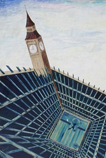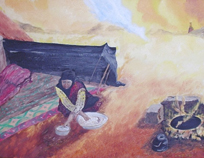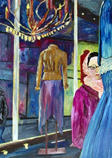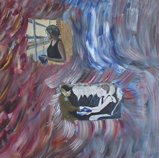Pathos in Colour
by Laxmi Birajdar
C K Purandare’s paintings initiate a dialogue on social issues through a globo-local perspective

‘Big Ben’ by C K Purandare

‘needs, not wants’ by C K Purandare

‘Russia’ by C K Purandare

‘all that glitters’ by C K Purandare

‘Iraq 2005’ by C K Purandare

‘fortress europe’ by C K Purandare
The marginalised and the under-privileged make you think. One look at artist C K Purandare’s work and we know a society in denial needs to wake up. ‘‘ I think ‘Art should be aesthetic’ is an elitist approach. I have no intention of being recognised as an artist. For me, my work is a means of initiating a dialogue on issues that are usually brushed under the carpet.’’ Asserts, Scotland-based Purandare, who will be show-casing his work at Su-Darshan Art Gallery, starting this Sunday.
And the glimpses are poignant. While yet another candle is a condolence to the victims of narco-terrorism in Latin America, The Second Exodus signifies that for the first time in human history, this decade will see more than half of the world’s population living in cities. Pointing at another work titled Prison, Purandare says,‘‘ Do you know that today, more than nine million people are languishing in prisons all over the world? Totalitarian regimes in China, North Korea and Africa do not reveal exact figures of prisoners to avoid criticism from human rights organisations.’’ Purandare reflects with a bird’s eye-view of global problems. Some of his thought-provoking realistics depict women in Iraq, Nandigram and the daily struggle for water in rural India.
An engineer by profession, Purandare traveled to remote areas of India to acquaint himself with issues there. ‘‘ I also wrote some research papers and articles on the same and did social work simultaneously, some ten years ago,’’ he adds. That’s exactly what prompted him to do his M A in sociology from the University of Pune. But he ended up disappointed. ‘‘ I realised that academics was so different from practical reality. It was extremely disillusioning to study sociology because I was learning something – education influences of which were drawn from the West and that did not befit the Indian context,’’ he mentions.
Finally it was art that channelised his thought. ‘‘One fine day, I just gathered some painting material and began to paint my thoughts on social issues,’’ says Purandare, whose initial paintings were rejected outright by art fraternity in Scotland and Pune. ‘‘ Some artists I showed my work to said technically I was raw and wasn’t artist material. But I didn’t care about being aesthetically perfect. I just wanted my art to convey important messages,’’ he adds.
‘Russia’ by C K Purandare
‘all that glitters’
‘Russia’ by C K Purandare
‘all that glitters’ by C K Purandare
And his artistic endeavours have further been strengthened by his experiences in Scotland. ‘‘There is tremendous ignorance about India in the West, especially regarding our social and economic problems. Too many cliches, prejudices coupled with an unwillingness to take action,’’ he points out.
But Purandare’s contributions have come in handy. Some of his paintings have graced the covers of serious magazines like Andolan and Anubhav. He is also on the editorial team of Stride, a quarterly magazine of the International Development Association of Scotland and via community forums there, Purandare also conducts talks on various social issues.
‘Iraq 2005’ by C K Purandare
‘fortress europe’
‘Iraq 2005’ by C K Purandare
‘fortress europe’ by C K Purandare
And for someone who says it best with images, Purandare is planning his next series – that on family members as care takers of each others and their problems.
The Indian Express – Art Beat – July 19, 2007